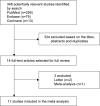Comparison between the long-axis/in-plane and short-axis/out-of-plane approaches for ultrasound-guided vascular catheterization: an updated meta-analysis and trial sequential analysis
- PMID: 29503552
- PMCID: PMC5824754
- DOI: 10.2147/TCRM.S152908
Comparison between the long-axis/in-plane and short-axis/out-of-plane approaches for ultrasound-guided vascular catheterization: an updated meta-analysis and trial sequential analysis
Abstract
Background: A long-axis in-plane (LA-IP) approach and a short-axis out-of-plane (SA-OOP) approach are the two main approaches used in ultrasound (US)-guided vascular catheterization. However, the efficacy and safety of these approaches remain controversial. Therefore, we performed this meta-analysis to compare the two techniques in vascular catheterization.
Materials and methods: Relevant studies were searched in PubMed, Embase, and the Cochrane Library databases from database inception until August 2017. Randomized controlled trials comparing a long-axis approach with a short-axis approach for US-guided vascular cannulation were selected. The RevMan software was used to analyze the results, and trial sequential analysis (TSA) was further applied to determine whether the currently available evidence was sufficient and conclusive.
Results: Eleven studies met the inclusion criteria. Overall, 1,210 patients were included. The total success rate was similar between the SA-OOP and LA-IP approaches for US-guided vascular catheterization (risk ratio [RR], 1.01; 95% CI, 0.99-1.04; P=0.35; I2=48%). In the radial artery (RA; RR, 1.00; 95% CI, 0.96-1.05; P=0.88; I2=49%) and internal jugular vein (IJV; RR, 1.00; 95% CI, 0.98-1.02; P=0.99; I2=0%) subgroups, the total success rate was also similar and was confirmed by the TSA. For populations with subclavian vein (SCV) and axillary vein catheterization, the SA-OOP approach showed a benefit for first-attempt success rate. No significant differences in first-attempt success rate, cannulation times, or complications were found between the two approaches.
Conclusion: Despite a similar total success rate between the SA-OOP approach and the LA-IP approach when used for RA and IJV catheterization (as confirmed by TSA), further robust well-designed trials are warranted to evaluate other outcomes. There is insufficient evidence to definitively state that the SA-OOP approach was superior to the LA-IP approach when used for SCV and axillary vein catheterization. High-quality trials are needed to confirm or refute this finding.
Keywords: internal jugular vein; long-axis in-plane; radial artery; short-axis out-of-plane; ultrasound guidance; vascular catheterization.
Conflict of interest statement
Disclosure The authors report no conflicts of interest in this work.
Figures





Similar articles
-
Comparison of out-of-plane short axis with in-plane long axis for ultrasound-guided radial arterial cannulation: A systematic review with trial sequential analysis of randomised controlled trials.Front Cardiovasc Med. 2022 Oct 12;9:983532. doi: 10.3389/fcvm.2022.983532. eCollection 2022. Front Cardiovasc Med. 2022. PMID: 36312257 Free PMC article.
-
Ultrasound-guided short-axis out-of-plane vs. long-axis in-plane technique for radial artery catheterization: an updated meta-analysis of randomized controlled trials.Eur Rev Med Pharmacol Sci. 2022 Mar;26(6):1914-1922. doi: 10.26355/eurrev_202203_28337. Eur Rev Med Pharmacol Sci. 2022. PMID: 35363340
-
Comparison between the long-axis in-plane and short-axis out-of-plane approaches for ultrasound-guided arterial cannulation: a meta-analysis and systematic review.BMC Anesthesiol. 2023 Apr 13;23(1):120. doi: 10.1186/s12871-023-02076-2. BMC Anesthesiol. 2023. PMID: 37055775 Free PMC article.
-
Ultrasound-guided radial arterial cannulation: long axis/in-plane versus short axis/out-of-plane approaches?J Clin Monit Comput. 2013 Jun;27(3):319-24. doi: 10.1007/s10877-013-9437-6. Epub 2013 Feb 16. J Clin Monit Comput. 2013. PMID: 23417581 Clinical Trial.
-
Effects of long axis in-plane vs short axis out-of-plane techniques during ultrasound-guided vascular access.Am J Emerg Med. 2016 May;34(5):778-83. doi: 10.1016/j.ajem.2015.12.092. Epub 2016 Jan 6. Am J Emerg Med. 2016. PMID: 26830218
Cited by
-
Comparison of novel anteroposterior short-axis in-plane technique with conventional short-axis out-of-plane technique for ultrasound-guided internal jugular vein cannulation: A randomized-controlled trial.Turk J Emerg Med. 2023 Jan 2;23(1):17-23. doi: 10.4103/2452-2473.366485. eCollection 2023 Jan-Mar. Turk J Emerg Med. 2023. PMID: 36818948 Free PMC article.
-
Short-axis versus long-axis approach for ultrasound-guided vascular access: An updated systematic review and meta-analysis of randomised controlled trials.Indian J Anaesth. 2023 Nov;67(Suppl 4):S208-S217. doi: 10.4103/ija.ija_965_22. Epub 2023 Nov 21. Indian J Anaesth. 2023. PMID: 38187975 Free PMC article.
-
Comparison of out-of-plane short axis with in-plane long axis for ultrasound-guided radial arterial cannulation: A systematic review with trial sequential analysis of randomised controlled trials.Front Cardiovasc Med. 2022 Oct 12;9:983532. doi: 10.3389/fcvm.2022.983532. eCollection 2022. Front Cardiovasc Med. 2022. PMID: 36312257 Free PMC article.
-
Knowledge, attitude, and practice of non-emergency surgical patients toward anesthesia.Sci Rep. 2024 Aug 1;14(1):17763. doi: 10.1038/s41598-024-68808-7. Sci Rep. 2024. PMID: 39085629 Free PMC article.
-
Comparison of short and long axis ultrasound-guided approaches to internal jugular vein puncture: a meta-analysis.J Int Med Res. 2019 Sep;47(9):4069-4082. doi: 10.1177/0300060519867806. Epub 2019 Aug 20. J Int Med Res. 2019. PMID: 31429352 Free PMC article.
References
-
- Moore CL. Ultrasound first, second, and last for vascular access. J Ultrasound Med. 2014;33(7):1135–1142. - PubMed
-
- Randolph AG, Cook DJ, Gonzales CA, Pribble CG. Ultrasound guidance for placement of central venous catheters: a meta-analysis of the literature. Crit Care Med. 1996;24(12):2053–2058. - PubMed
-
- Gao YB, Yan JH, Gao FQ, Pan L, Wang XZ, Lv CJ. Effects of ultrasound-guided radial artery catheterization: an updated meta-analysis. Am J Emerg Med. 2015;33(1):50–55. - PubMed
LinkOut - more resources
Full Text Sources
Other Literature Sources
Research Materials
Miscellaneous

